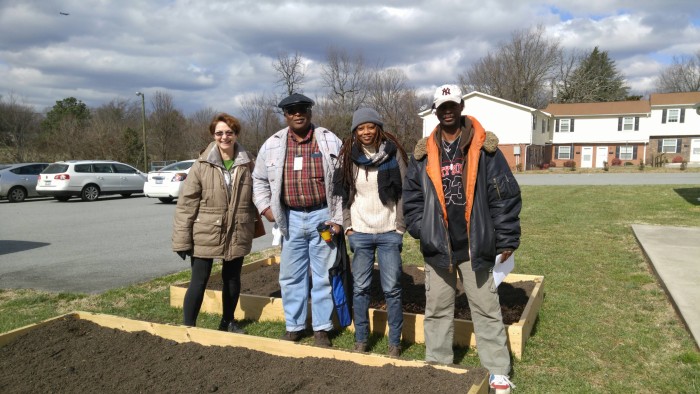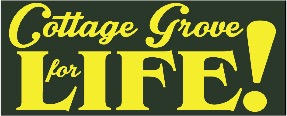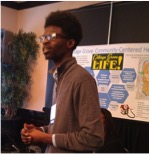
I have the tremendous pleasure of working with the Cottage Grove Neighborhood Association and Community-Centered Health Partners as they revitalize the community, engaging outside resources to support that vision rather than to dislocate neighborhood residents. Meet some of the amazing leaders whose energy is guiding that process to transform the neighborhood.
Photo above, left to right: Laura Tew (Cooperative Extension Master Gardener), Rev. Marvin Richmond (New Hope Community Development Group), Shorlette Ammons-Stephens (NC A&T, Center for Environmental Farming Systems), and Barry Campbell (New Hope Community Development Group).
From Decline to Rebirth
Imagine reclaiming your community’s identity after decades of being defined by others. The Cottage Grove neighborhood in southeast Greensboro bustled with shops and professionals in the 1950’s and 60’s; in 1976 the main street was renamed South English and became a cut-through from East Market to Lee Street. Business closings, little investment, and many broken promises later, neighbors formed the Cottage Grove Neighborhood Association and adopted the theme “Cottage Grove for LIFE!” to proclaim the new energy for a healthy place to live. Now they are holding outside groups—and themselves—accountable to make that happen, together.
 The vision for that future is bright. Community residents contacted over 300 of their neighbors to ask about priorities and the top responses included a health clinic, jobs, better housing, vegetable gardens, bus shelters, safe parks, and English for Speakers of Other Languages.
The vision for that future is bright. Community residents contacted over 300 of their neighbors to ask about priorities and the top responses included a health clinic, jobs, better housing, vegetable gardens, bus shelters, safe parks, and English for Speakers of Other Languages.
Dedicated partners are supporting the neighborhood to reach that vision. They presented this poster at UNC Minority Health Conference.
Partners and Progress
And some of the bright future is now, 2016, with many positive developments
- the opening of Mustard Seed Community Health’s primary care services on South English
- raised garden beds in the backyard, planted by New Hope Community Development Group
- English and GED classes Tuesday and Thursday evening
- Greensboro Housing Coalition’s help advocating to rental property owners about housing-related health risks and discrimination
- Renovation of disastrously substandard apartments, through the efforts of Cottage Grove Initiative
- Hampton Circle of Friends organizing strong support for Hampton Elementary School’s amazing staff
- Wonderful relationships with Cone Health, UNCG, NC A&T, and Cooperative Extension
- A Community-Centered Health grant from BCBSNC Foundation for hiring a coordinator and Community Health Workers—jobs for the neighborhood.
The momentum is building.
Cottage Grove Neighborhood Association reaches out to neighbors to let everyone know that this time, instead of broken promises, positive changes are underway.
But this is not a magic wand that others wave to make everything perfect. This is the opportunity to transform the community from the inside, based on the goals and the efforts of neighbors—although supported by the time, expertise, and funds offered by partners.
This is the opportunity to learn leadership skills: how to get neighbors to raise their voices effectively and to dig into the work (literally, in the case of community gardens), how to make the most of the contributions of eager college students and church groups while clearly defining the community’s own identity, how to stand up for their own vision in the tension between the egos of others.
The neighborhood association is planning leadership development trainings and health outreach fairs, to attract more neighbors to see that they really can create the future that they envision.
Introducing some of the Cottage Grove community leaders:
Verna Torain (on left, below) bought a home in Cottage Grove 25 years ago and for many years made phone calls seeking attention to the needs of her community. When she heard of meetings about reclaiming Cottage Grove, she showed up—every time. After listening quietly in the back of the room, she agreed to be president of the newly formed neighborhood association—and became the spokesperson, traveling to conferences to tell about the vision of Cottage Grove for LIFE!
 Pat Macfoy (on right, red shirt) began visiting door-to-door in the Cottage Grove neighborhood when she was a child, accompanying her father, pastor of New Hope Missionary Baptist Church, as he reached out in service to the community. After a career as Senior VP of Human Resources, Insurance and Risk Management officer at Girl Scouts, she continues that legacy as Executive Director of New Hope Community Development Group.
Pat Macfoy (on right, red shirt) began visiting door-to-door in the Cottage Grove neighborhood when she was a child, accompanying her father, pastor of New Hope Missionary Baptist Church, as he reached out in service to the community. After a career as Senior VP of Human Resources, Insurance and Risk Management officer at Girl Scouts, she continues that legacy as Executive Director of New Hope Community Development Group.
 Yusuf Olokoba graduated from high school at 16 and will be studying engineering and science at Dartmouth College—full scholarship. In the meantime, he is volunteering at Hampton Elementary to introduce young students to robotics and inspiring them to dream of exciting careers.
Yusuf Olokoba graduated from high school at 16 and will be studying engineering and science at Dartmouth College—full scholarship. In the meantime, he is volunteering at Hampton Elementary to introduce young students to robotics and inspiring them to dream of exciting careers.
 Josie Alston Williams grew up in the community and knows firsthand the challenges families face. She is pouring all her experience in life, in Guilford College, and in internships at Greensboro Housing Coalition and Washington DC into her new work as coordinator of the Community-Centered Health partnership, building capacity for shared leadership.
Josie Alston Williams grew up in the community and knows firsthand the challenges families face. She is pouring all her experience in life, in Guilford College, and in internships at Greensboro Housing Coalition and Washington DC into her new work as coordinator of the Community-Centered Health partnership, building capacity for shared leadership.
Next steps for Cottage Grove? Reaching out to more neighbors, learning advocacy skills, visiting other communities who have stood up for themselves around community development and environmental hazards. After all, the park in Cottage Grove was once a landfill and neighbors want to know the results of environmental tests.
Share with us your experiences for healthy communities!

What an inspiring post! Thank-you for taking the time to write about this for the CELE blog Beth. I really like how you shone a spotlight on some of the people taking a leadership role to really make things happen too. I think this is a wonderful example of assets-based community development, not to mention of positive community engagement. I would love to hear more about the supportive institutions though and how they were able to work with the community to get things going. It looks like Cooperative Extension is involved, for example. I wonder what role they have played, as well as the City of Greensboro or other key institutions there. It seems to me that the greatest synergies come when there is leadership and engagement “on the ground” working with organizations that are in a position to help provide direction or assistance where needed. Thanks again!
Rick, thank you for asking about the supportive institutions. Indeed, the synergy comes from the dedication of diverse organizations to partnership “on the ground” with the Cottage Grove neighborhood. Four nonprofit organizations support Cottage Grove Neighborhood Association as core partners for Community-Centered Health:
1. New Hope Community Development Group takes the lead in neighborhood engagement and leadership development. NHCDG coordinates GED and ESOL classes with GTCC and promotes community gardens with community residents, Cooperative Extension, and NC A&T State University students.
2. Greensboro Housing Coalition is the advocate for fair, safe, and affordable housing and a nationally-recognized leader in healthy homes, demonstrating that housing interventions can reduce asthma triggers and hospital costs. GHC assists neighborhood residents with housing problems and manages the Cottage Grove grant from BCBSNC Foundation for Community-Centered Health.
3. Cottage Grove Initiative connects Cottage Grove with Purpose Built Communities, a network of cities revitalizing neighborhoods through housing development, excellent education, and community services. CGI has encouraged rental investors to purchase and rehabilitate seriously substandard housing, church groups to contribute books and volunteer time to Hampton Academy (elementary school), and universities and resource organizations to partner with neighborhood residents.
4. Mustard Seed Community Health provides primary medical care–the top priority identified by the community–and is planning for health outreach teams for social workers, nurses, and nutritionists to serve neighbors in their homes. Even before the health center opened, Dr. Mulberry invited her church to join New Hope Missionary Baptist in providing music, art, reading, and enrichment activities at Hampton Academy.
In addition, these core partners have engaged Cone Health, UNCG’s Center for Housing and Community Studies, faith communities, and the resource institutions named above. The neighborhood association has the majority of the votes in decisions that the partnership makes about strategies, the involvement of resource institutions, and the use of grant funds (within the requirements of funders).
I found this story inspiring as well. There are communities all over the state (and nation!) that could benefit from learning about the CGI work. Are there folks in the leadership who might be willing to talk with interested groups in other communities about how to get something like this started in their communities? What do you think are the greatest contributions that colleges and universities in the area can make to such efforts?
Katy, thank you for your comment and questions. I talked with neighborhood leadership and they will be happy to share their experience with other communities. We really appreciate the contributions of universities and colleges; see what would work for your university! NC A&T State University has a long-standing partnership with Hampton Elementary; in fact, it is called Hampton University Partnership Academy. Now agriculture students are working with the community gardens. Other A&T students canvassed the neighborhood last Saturday led by UNCG’s Center for Housing and Community Studies, to engage neighbors and collect data about housing conditions and property ownership. UNCG, A&T, and Guilford College students in nursing, social work, nutrition, and public health will be working with the Health Outreach Teams, along with Community Health Workers from Cottage Grove. A UNCG history student helped research neighborhood history for a Heritage recognition application. Musicians engage the children in rhythm and jazz on “Hampton Saturdays” enrichment days. There are dozens of possibilities for mutual learning between neighborhoods and universities, with the focus on respecting and empowering the neighborhoods.